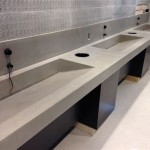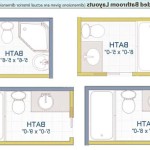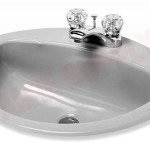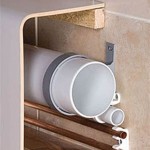Rustic 2 Sink Bathroom Vanity: A Comprehensive Guide
The rustic 2 sink bathroom vanity has become a prominent fixture in modern bathroom design, blending functionality with a distinct aesthetic appeal. Characterized by natural materials, textured finishes, and an often distressed or weathered look, these vanities offer a warm and inviting atmosphere. This article examines the defining features, the materials used, considerations for installation, and design options associated with rustic 2 sink bathroom vanities.
Defining Characteristics of Rustic Style
Rustic design, in general, emphasizes natural and organic elements. This translates to several distinct characteristics in rustic bathroom vanities. First, the reliance on natural materials like wood is paramount. Often, these vanities are constructed from solid wood or wood veneers, showcasing the grain and knots inherent in the material. Reclaimed wood is a particularly popular choice, adding a story and history to the piece. The wood is often left with a somewhat rough finish, preserving its original texture and imperfections. This can include visible saw marks, knots, and variations in color that contribute to the overall rustic aesthetic.
Second, the hardware used on rustic vanities plays a crucial role in establishing the desired style. Common choices include wrought iron, bronze, or antique brass pulls and knobs. These materials complement the wood and add a touch of robustness. The hardware often features a simple, functional design rather than elaborate ornamentation. The visual weight of the hardware also tends to be greater, making them stand out against the natural wood.
Finally, the color palette of rustic vanities typically revolves around natural tones. Browns, creams, and grays are dominant, reflecting the colors found in nature. These earthy tones create a soothing and relaxing environment. In some cases, muted blues or greens might be incorporated to add subtle color, but the overall emphasis remains on neutrality. The finish is often a distressed or antiqued look, achieved through techniques like sanding, staining, or glazing. This process adds depth and character to the vanity, giving it a sense of age and history.
Materials Commonly Used in Rustic Vanities
The selection of materials is critical in achieving the desired rustic effect. Wood, as previously mentioned, is the primary material. Different types of wood offer varying degrees of durability and aesthetic appeal. Oak, with its prominent grain and robust nature, is a popular choice. Pine is a more affordable option that can be easily stained or painted to achieve the desired look. Maple is another durable hardwood that can be used for its smooth surface and light color. Reclaimed wood, sourced from old barns, factories, or other structures, offers a unique character and sustainable option.
The countertop material must also complement the rustic aesthetic. Options include natural stone, such as granite, marble, or slate. These materials offer durability and a luxurious feel. Concrete countertops are a more industrial choice that can be stained or polished to create a unique look. Butcher block countertops, made from solid wood strips, provide a warm and inviting surface. The choice of sink material is also important. Undermount sinks, typically made of porcelain or fireclay, provide a clean and seamless look. Vessel sinks, which sit on top of the countertop, can add a dramatic and stylish element. Copper or hammered metal sinks further contribute to the rustic atmosphere.
The hardware used on rustic vanities is typically made of metal, often wrought iron, bronze, or antique brass. These materials are chosen for their durability and their ability to complement the wood finish. The hardware should be appropriately sized for the vanity and easy to grip. The design should be simple and functional, avoiding excessive ornamentation. The legs or supports of the vanity can also be made of metal or wood. Wooden legs can be simple and straight or more elaborately carved. Metal legs can add an industrial touch to the vanity.
Installation Considerations
Installing a rustic 2 sink bathroom vanity requires careful planning and attention to detail. The first step is to measure the available space in the bathroom. This includes the width, depth, and height of the vanity. It is important to consider any obstructions, such as pipes or electrical outlets. Ensuring that the vanity fits comfortably within the available space and allows for adequate clearance around it is critical. Furthermore, it is imperative to confirm that the chosen vanity configuration aligns with existing plumbing configurations, or requires modification for seamless integration.
Once the vanity has been delivered, it is important to inspect it carefully for any damage. Check the wood finish, the hardware, and the countertop for any scratches, dents, or cracks. If any damage is found, contact the vendor immediately. Before beginning the installation, turn off the water supply to the bathroom. This will prevent any leaks or flooding during the installation process. Disconnect the existing plumbing fixtures, including the sink, faucet, and drain.
Position the new vanity in its intended location. Use a level to ensure that it is perfectly square. If the floor is uneven, use shims to level the vanity. Once the vanity is level, secure it to the wall using screws or anchors. Connect the plumbing fixtures, including the sink, faucet, and drain. Ensure that all connections are tight and leak-free. Turn on the water supply and check for any leaks. If any leaks are found, tighten the connections until they are sealed. Install the countertop and sinks. The countertop may need to be sealed to protect it from water damage. The sinks should be securely attached to the countertop. Finally, install the hardware, including the pulls and knobs. Ensure that the hardware is properly aligned and securely attached.
Design Options and Customization
Rustic 2 sink bathroom vanities offer a wide range of design options and customization possibilities. The size and shape of the vanity can be customized to fit the specific needs of the bathroom. Common sizes range from 60 inches to 72 inches wide, but custom sizes can be made to order. The depth and height of the vanity can also be customized. The configuration of the vanity can include drawers, cabinets, or a combination of both. Drawers are ideal for storing smaller items, while cabinets are better suited for larger items. The layout of the drawers and cabinets can be customized to suit individual needs.
The finish of the vanity can be customized to match the existing décor of the bathroom. Options include staining, painting, or distressing the wood. Different stains can be used to achieve different shades of brown, gray, or other colors. Paint can be used to create a more contemporary look. Distressing the wood adds a sense of age and character to the vanity. The countertop material can also be customized. Options include granite, marble, slate, concrete, or butcher block. Each material offers a different look and feel. The sink style can also be customized. Options include undermount sinks, vessel sinks, or farmhouse sinks. Undermount sinks provide a clean and seamless look, while vessel sinks add a dramatic and stylish element. Farmhouse sinks are a more traditional choice.
The hardware used on the vanity can also be customized. Options include wrought iron, bronze, antique brass, or stainless steel. Different hardware styles can be used to achieve different looks. The legs or supports of the vanity can also be customized. Options include wooden legs, metal legs, or no legs at all. Wooden legs can be simple and straight or more elaborately carved. Metal legs can add an industrial touch to the vanity. The addition of shelving or open storage can further enhance the functionality of the vanity. Open shelves can be used to display towels, toiletries, or decorative items. The inclusion of lighting, such as under-cabinet lighting or sconces, can add a touch of ambiance to the bathroom.
Maintenance and Care
Proper maintenance and care are essential to preserving the beauty and longevity of a rustic 2 sink bathroom vanity. Regular cleaning is crucial to prevent the buildup of dirt, dust, and grime. Use a soft cloth or sponge to wipe down the vanity surface with a mild soap and water solution. Avoid using abrasive cleaners or harsh chemicals, as these can damage the finish. Dry the vanity thoroughly after cleaning to prevent water spots.
Protecting the wood finish is also important. Apply a sealant or varnish to the wood surface to protect it from moisture and scratches. Reapply the sealant or varnish as needed, typically every few years. If the vanity has a stone countertop, seal it regularly to prevent staining. Avoid placing hot items directly on the countertop, as this can cause damage. Wipe up spills immediately to prevent staining.
Inspect the plumbing regularly for any leaks. If any leaks are found, repair them immediately to prevent water damage. Check the hardware regularly to ensure that it is securely attached. Tighten any loose screws or bolts. Replace any damaged hardware. By following these maintenance and care tips, one can ensure that their rustic 2 sink bathroom vanity retains its beauty and functionality for many years.

Rustic Farmhouse Double Bath Vanity With Angelarosediyhome Ana White

Farmhouse Bathroom Vanity Double Sink Rustic

Rustic Farmhouse Double Vanity Spruc D Market

Accos 60 Inch Rustic Double Sink Bathroom Vanity Marble Top

60 Inch Rustic Double Sink Bathroom Vanity Wk1860 Marble Top

Real Hickory Rustic Bathroom Vanity 48 72

Rustic Farmhouse Double Bath Vanity With Angelarosediyhome Ana White

Farmhouse Bathroom Vanity Double Sink Rustic Finland

48 Bozeman Rustic Bathroom Vanity In Natural With Calacatta Quartz To Housetie

Water Creation Aberdeen 60 In Rustic Sienna Undermount Double Sink Bathroom Vanity With White Natural Marble Top Mirror And Faucet Included The Vanities Tops Department At Com







